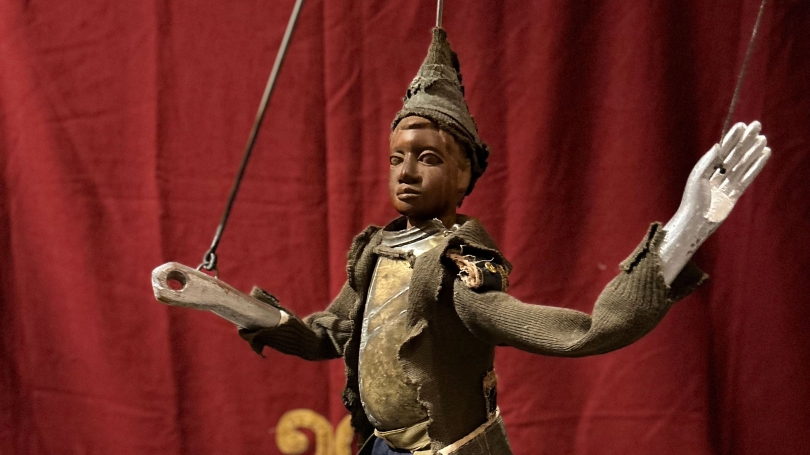
- Undergraduate
- Graduate
- Performance
- Foreign Study
- News & Events
- People
Back to Top Nav
Back to Top Nav
Back to Top Nav
Back to Top Nav
Back to Top Nav
Back to Top Nav
On Tuesday, April 18th and Wednesday, April 19th at Dartmouth Hall, puppeteer Mimmo Cuticchio and his theater association, Figli d'Arte Cuticchio, are enacting a version of the Faust Legend called La Storia del Soldato (The Story of a Soldier) using Sicilian Puppets. They are accompanied by a septet of musicians, conducted by Filippo Ciabatti, Director of Orchestral and Choral Programs, who bring Stravinsky's spare and striking score to life. Cuticchio's work is a continuation of an ancient tradition of puppetry as a medium for dealing with complex human emotions. La Storia del Soldato in particular deals with difficult human feelings of ambition, desperation and discontentedness.
"Puppets are seen by some as lowly and vulgar," professor Michael Wyatt said. "For this very reason puppet theater flies under the radar, and by doing that it can address topics that for many centuries regular theater couldn't address because it would have been far too dangerous. [Puppet theater] is subversive and challenges cultural norms."
Wyatt teaches a course at Dartmouth called Global Traditions of Puppetry and worked closely with Figli d'Arte Cuticchio to bring La Storia del Soldato to the Hop. He explained that throughout history, puppet theater was an immensely popular medium of storytelling. Because in centuries past it did not attract attention from those in power, there is an edgy political underlay in puppet tradition. For example, ancient Sicilian puppetry dealt with issues of colonization and the Sicilian sensibility that their land belongs to someone else. The stories of these ancient puppets eventually coalesced into a literary tradition of epic poetry, but the puppet tradition was not lost. In modern times, puppet theater maintained its popularity in Western television with shows such as Sesame Street and Kukla, Fran, and Ollie. Cuticchio's work draws on stories that have been passed down by narrators of the past. Wyatt believes that Cuticchio is the last of the cunti, or, a traditional Sicilian storyteller and master of the art of cunto.
"Mimmo realized in the 70s with the collapse of so many puppet theaters, in order for the tradition to continue, it was going to have to renew itself," Wyatt said. "One of the ways he has done that is by creating new shows that address issues that have previously never been touched in this industry."
Cunto is a craft that younger Sicillians have not mastered, Wyatt explained, because it demands a large investment of time and energy without evident return. With the rise of television and film throughout the 20th century, the audience for traditional puppetry dwindled. The performance documentary Figli d'Arte Cuticchio, shown as part of the Hop Film Event season, goes behind the scenes of puppet theater and further explains how Cuticchio has reimagined the puppet tradition. Wyatt believes the art of storytelling through material things is a wonderful practice that should not be forgotten because puppets achieve something that humans cannot.
"We tend to think of puppets as these inanimate dolls, but there's a very real sense that these material objects are not just that," Wyatt said. "Their life depends entirely on the puppeteers and handlers giving them life, but in the negotiation between the human handler and the [puppet], there's a kind of magic that takes place and it transforms that material thing into something that mirrors humans in a way that human [actors] are often reluctant to do. The puppet, in its material autonomy, isn't subject to [societal] constraints."
In conventional theater, Wyatt explained, even the best human actors have their own personalities that they inevitably convey. Human actors also possess a level of self-consciousness and belong to a human hierarchy to which puppets do not.
"[In puppetry], the movements provoked by the handler come from a human source but by traveling through the puppet, self-consciousness disappears," Wyatt said. "One of the magical things a puppet can do is, because it lacks subjectivity, it appeals to humans. All of us have a deep sense of struggling, it's part of being human. To witness a community of objects that appear human going about posing questions about our world, there's something about the space between us and them that makes it possible for a kind of exchange about these things that occupy us."
Furthermore, the craftsmanship involved in the making of the puppets elevates the art of puppet theater, as well, and contributes to the wonder. For example, the puppet protagonist of La Storia del Soldato has a head made from a rare African wood; a chunk of this wood was gifted to the Figli d'Arte Cuticchio puppeteers during their 2017 tour.
"The head is the most expressive part of the puppet's body, and [the puppeteers] felt there was something in this wood that spoke to them and suggested this is the proper form it should take," Wyatt said. "These people consider themselves much more artisans than performing artists. They construct their puppets, maintain them, they paint the scenery. All of the hard work is work they do with their own hands. It's a distinctive part of this tradition. There's something intuitive about the process that contributes to the power of what they do."